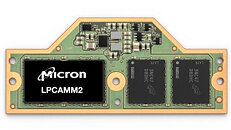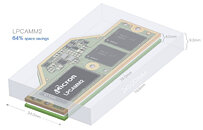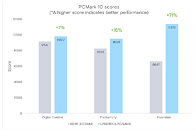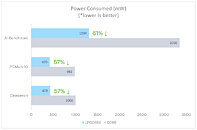TheLostSwede
News Editor
- Joined
- Nov 11, 2004
- Messages
- 18,470 (2.47/day)
- Location
- Sweden
| System Name | Overlord Mk MLI |
|---|---|
| Processor | AMD Ryzen 7 7800X3D |
| Motherboard | Gigabyte X670E Aorus Master |
| Cooling | Noctua NH-D15 SE with offsets |
| Memory | 32GB Team T-Create Expert DDR5 6000 MHz @ CL30-34-34-68 |
| Video Card(s) | Gainward GeForce RTX 4080 Phantom GS |
| Storage | 1TB Solidigm P44 Pro, 2 TB Corsair MP600 Pro, 2TB Kingston KC3000 |
| Display(s) | Acer XV272K LVbmiipruzx 4K@160Hz |
| Case | Fractal Design Torrent Compact |
| Audio Device(s) | Corsair Virtuoso SE |
| Power Supply | be quiet! Pure Power 12 M 850 W |
| Mouse | Logitech G502 Lightspeed |
| Keyboard | Corsair K70 Max |
| Software | Windows 10 Pro |
| Benchmark Scores | https://valid.x86.fr/yfsd9w |
Micron Technology, Inc. (Nasdaq: MU), today unveiled the industry's first standard low-power compression attached memory module (LPCAMM2) available in capacities from 16 GB to 64 GB, which delivers higher performance, energy-efficiency, space savings and modularity for PCs. Sampling now with production in the first half of 2024, LPCAMM2 is the first disruptive new form factor for client PCs since the introduction of small outline dual inline memory modules (SODIMMs) in 1997. Micron's LPDDR5X DRAM incorporated into the innovative LPCAMM2 form factor will provide up to 61% lower power and up to 71% better performance for PCMark 10 essential workloads such as web browsing and video conferencing, along with a 64% space savings over SODIMM offerings.
As generative artificial intelligence (GAI) use cases proliferate to client PCs, performance of the memory subsystem becomes more critical. LPCAMM2 delivers the required performance to process AI workloads on PCs and provide the potential to scale to applications needing a high performance and low power solution in a compact and modular form factor, with the ability to upgrade low power DRAM for the first time, as customer needs evolve.




"Micron is transforming the laptop user's experience with the LPCAMM2 product that will deliver best-in-class performance per watt in a flexible, modular form factor," said Praveen Vaidyanathan, vice president and general manager of Micron's Compute Products Group. "This first-of-its-kind product will enhance the capabilities of AI-enabled laptops, whose memory capacity can be upgraded as technology and customer needs evolve."
Micron's leadership in JEDEC and collaboration with key client PC OEMs and ecosystem enablers helped design and develop the LPCAMM2 form factor. Beyond product development, delivering this new type of memory has involved numerous innovations for test hardware, testing methodologies and automation technologies that will enable an efficient production ramp. Additional benefits of Micron's LPCAMM2 include:
"LPCAMM2 is a dynamic new form factor for the PC ecosystem that enables higher performance, scalable memory capacity, and improved battery life for mobile workstations and thin and light laptops," said Yasumichi Tsukamoto, executive director and distinguished engineer, Commercial Product Solutions Development at Lenovo. "We are proud of our strong relationship and joint development effort with Micron to be one of the first to market in bringing this flexible memory offering to our customers. In addition to the enhanced user experience, the low power memory used in these modules aligns with our goals to reduce energy consumption in our laptops."
"Intel and Micron, in close collaboration with key industry PC leaders, are reimagining the client PC space through the development of optimized new platform designs, powered by Micron's LPCAMM2 form factor. The technical advantages of LPCAMM2 technology enable Intel and its ecosystem partners to advance sustainable low-power memory technology solutions and exciting new PC designs for the age of the AI PC," said Dr. Dimitrios Ziakas, vice president of Memory and IO Technology at Intel. "We remain committed to our collaboration with the ecosystem, paving the path for future adoption and innovation."
"The use of large language models and AI applications on edge devices like laptops and mobile workstations is a key focus area for our future customer-focused designs," said Andy Lee, senior vice president of Compal. "Compal is working closely with Micron to design platforms that are going to fuel the AI revolution based on the high bandwidth, low power, and high-capacity capabilities of Micron's LPCAMM2 memory solutions."
Micron will also offer end customers Crucial LPCAMM2 memory offerings to provide laptop users like gamers, on-the-go professionals and content creators with the ability to upgrade their memory themselves, an industry first for low-power memory due to the upgradeable design of this new form factor. Crucial LPCAMM2 products will be available in the first half of 2024 on www.crucial.com.
[Editor's note: Pictures of the actual module from CES can be found in this news post]
View at TechPowerUp Main Site | Source
As generative artificial intelligence (GAI) use cases proliferate to client PCs, performance of the memory subsystem becomes more critical. LPCAMM2 delivers the required performance to process AI workloads on PCs and provide the potential to scale to applications needing a high performance and low power solution in a compact and modular form factor, with the ability to upgrade low power DRAM for the first time, as customer needs evolve.




"Micron is transforming the laptop user's experience with the LPCAMM2 product that will deliver best-in-class performance per watt in a flexible, modular form factor," said Praveen Vaidyanathan, vice president and general manager of Micron's Compute Products Group. "This first-of-its-kind product will enhance the capabilities of AI-enabled laptops, whose memory capacity can be upgraded as technology and customer needs evolve."
Micron's leadership in JEDEC and collaboration with key client PC OEMs and ecosystem enablers helped design and develop the LPCAMM2 form factor. Beyond product development, delivering this new type of memory has involved numerous innovations for test hardware, testing methodologies and automation technologies that will enable an efficient production ramp. Additional benefits of Micron's LPCAMM2 include:
- Higher performance with LPDDR5X to achieve speeds up to 9600 Mbps versus 5600 Mbps with current DDR5 SODIMMs
- Up to 80% system standby power savings to improve battery life
- Up to 7% better performance for digital content creation workloads
- Up to 15% improvement for productivity workloads in PCMark 10 tests
- Modularity to enable critical serviceability functionality for enterprise IT users and administrators
- Single PCB for all module capacities to provide supply chain flexibility to OEM and ODM customers
- Simplified motherboard routing complexity compared to SODIMM
- Crucial LPCAMM2 retail products allow laptop PC users the ability to upgrade their system memory configuration
"LPCAMM2 is a dynamic new form factor for the PC ecosystem that enables higher performance, scalable memory capacity, and improved battery life for mobile workstations and thin and light laptops," said Yasumichi Tsukamoto, executive director and distinguished engineer, Commercial Product Solutions Development at Lenovo. "We are proud of our strong relationship and joint development effort with Micron to be one of the first to market in bringing this flexible memory offering to our customers. In addition to the enhanced user experience, the low power memory used in these modules aligns with our goals to reduce energy consumption in our laptops."
"Intel and Micron, in close collaboration with key industry PC leaders, are reimagining the client PC space through the development of optimized new platform designs, powered by Micron's LPCAMM2 form factor. The technical advantages of LPCAMM2 technology enable Intel and its ecosystem partners to advance sustainable low-power memory technology solutions and exciting new PC designs for the age of the AI PC," said Dr. Dimitrios Ziakas, vice president of Memory and IO Technology at Intel. "We remain committed to our collaboration with the ecosystem, paving the path for future adoption and innovation."
"The use of large language models and AI applications on edge devices like laptops and mobile workstations is a key focus area for our future customer-focused designs," said Andy Lee, senior vice president of Compal. "Compal is working closely with Micron to design platforms that are going to fuel the AI revolution based on the high bandwidth, low power, and high-capacity capabilities of Micron's LPCAMM2 memory solutions."
Micron will also offer end customers Crucial LPCAMM2 memory offerings to provide laptop users like gamers, on-the-go professionals and content creators with the ability to upgrade their memory themselves, an industry first for low-power memory due to the upgradeable design of this new form factor. Crucial LPCAMM2 products will be available in the first half of 2024 on www.crucial.com.
[Editor's note: Pictures of the actual module from CES can be found in this news post]
View at TechPowerUp Main Site | Source






 react. lol
react. lol